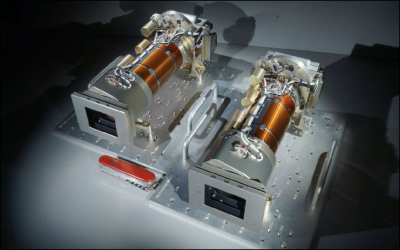Mastcam-Z
mission specific
Instrument Overview
Mastcam-Z is comprised of a pair of color, focusable, zoomable stereo cameras ("eyes") mounted on the rover’s Remote Sensing Mast (RSM). Each camera has identical zoom/focus capabilities but each has a different set of color filters. The camera heads are capable of zoom with focal lengths from 26 mm to 110 mm with a rotating, eight- position filter wheel. Their position on the RSM allows a large range of pointing in azimuth and elevation. Each eye can acquire images of up to 1648 x 1200 pixels and is capable of high frame rate acquisition (video) and on-board processing of focus stack images. They acquire color via Bayer-pattern filters on the CCD, but also have selectable superimposed narrowband filters for limited compositional applications. The cameras (shown in the figure below) have a variety of commandable parameters including filter position, subframing, compression, focus, focal length, and exposure settings. The Mastcam-Z camera system is described in more detail by Bell et al. (2020) and Hayes et al. (2020).

The two Mastcam-Z flight cameras, shown with a pocket knife for scale, are assembled and ready for testing in this photo taken at Malin Space Science Systems, in San Diego, California. Photo credit: MSSS/ASU.
Image sequences are obtained as single or multiple pointings through one or more of the following filters on each camera: a broadband, IR-cutoff filter (for “RGB” imaging, filter position 0), six narrow-band filters (filters 1–6) selected to characterize surface reflectance for multispectral science imaging, and two solar imaging filters (filter 7), one with an 880 nm filter and a 10-5 neutral density (ND) coating (R eye) and the other with a broadband IR-cutoff filter and a 10-6 ND coating (L eye).
The camera heads are connected to the rover via a Digital Electronics Assembly (DEA) that provides some onboard image-processing capabilities, including 11-to-8-bit companding (a term for compression, then later expanding; e.g., Bell et al., 2017), horizontal sub-framing, and image compression using either lossless predictive (Huffman-encoded; Malin et al., 2013) or lossy JPEG algorithms.
Uncompressed data have 11-bit (raw Data Numbers from 0 to 2047) dynamic range with no compression or color interpolation. Lossless compression typically yields ~1.7:1 compression and is not color interpolated. Lossy compression uses a Realtime JPEG algorithm with color interpolation or in grayscale, and with commandable color subsampling (4:4:4 or 4:2:2) and a commandable compression quality of 1 to 100. Lossy JPEG compression of the images is common, depending on downlink volume constraints, although in some cases some observations are retransmitted (as a recovered product) later losslessly. Video products can be commanded raw or as JPEG-compressed color-interpolated Groups of Pictures (GOPs; ≤ 2 MB file size and ≤ 16 frames/GOP), with commandable color subsampling and compression quality. Z stack products (for focus merges and range maps) can reduce as many as eight 1600 x 1200 raw images to a single 1600 x 1200 color JPEG and a grayscale JPEG range image. Lastly, companding performs 11-bit to 8-bit square-root encoding/decoding via lookup tables.
A summary of the filter set and the debayering methods used to generate the full-size images, along with a plot of Mastcam-Z spectral response, is shown below in the three figures below.
Mastcam-Z camera characteristics are shown in the table below.
| Mastcam-Z Operational Characteristics | |
|---|---|
| Characteristic | Value |
| Resolution (S x L) |
Resolution (S x L) 1648 x 1200 (1600 x 1200 photoactive pixels) |
| Bit Depth | 11 |
| Field of View (FOV) |
Wide: 25.6° x 19.2° Narrow: 6.2° x 4.6° |
| Baseline Stereo Separation | 24.4 cm |
| Toe-in | 1.15° |
| Pixel Size | 7.4 μm x 7.4 μm |
| Spatial Resolution (Wide Zoom) |
~0.6 mm/pix @ ~2 m range ~3 cm/pix @ 100 m range |
| Spatial Resolution (Narrow Zoom) |
~0.13 mm/pix @ ~2 m range ~6.7 mm/pix @ 100 m range |
| Angular Resolution |
26 mm focal length: 283 μrad/pix 110 mm focal length: 67.4 μrad/pix |
| Focal Length | 26 – 110 mm |
| f/number |
26 mm focal length: f/7 110 mm focal length: f/9 |
| Focus Range |
0.5m to ∞ for 26 to ~50mm 1m to ∞ for ~50 to 110mm |
| Number of Spectral Filters | 7 plus Broadband RGB Bayer pattern |
Mastcam-Z Zoom Motor counts and corresponding Focal Length values are listed in shown in the table below.
| Zoom motor count (z) | Focal length (f), mm |
|---|---|
| 0 | 26 |
| 2448 | 34 |
| 3834 | 48 |
| 5196 | 63 |
| 6720 | 79 |
| 8652 | 100 |
| 9600 | 110 |
The relationship of Zoom vs. Focal Length is approximated as a piecewise linear function. Thus for a given Zoom motor count, the corresponding focus F is defined by:
F = (f2-f1) / (z2-z1) × (z-z1) + f1
where z1,z2 are the min and max values of the range from the table containing z, and f1, f2 are the corresponding min and max focal lengths for the range.


